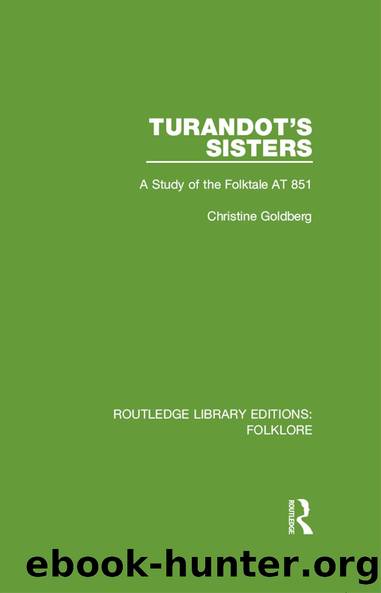Turandot's Sisters (RLE Folklore) by Christine Goldberg

Author:Christine Goldberg [Goldberg, Christine]
Language: eng
Format: epub
ISBN: 9781138845640
Barnesnoble:
Publisher: Taylor & Francis
Published: 2016-09-26T00:00:00+00:00
I. Cosmic Riddles
The three Turandot riddles have cosmic answers, as do riddles and wisdom questions in several tales from old literary sources.
Ia. The Year Riddle
Scholars have not yet completely clarified the relations of the comparisons of the year and the world to a tree. They may be dealing with two different ideas that have influenced each other or with two ideas that have sprung from the same root. ⦠Although many scholars have investigated the year riddle, no one has yet written a definitive account of its origins, connections, and disseminations (ER 1037â1038).
So wrote Archer Taylor. Ancient oriental literary versions, independent as well as in narratives, are crucial to this problem. The oldest such image is Vedic, from perhaps 1200 B.C.: âTwelve felloes on a single wheel, and three naves, who can understand it?â (Rig-Veda 1: 164, cf. 1: 11, 14) A similar image appears in the Mahabharata when Ashtavakra shows his wisdom to the king: âthe ever-turning wheelâ is the answer, with no overt mention of the year or the cosmos. In the Achikar manuscripts the image is of a temple, in the Arabic, âWhat do you know of a builder, who built a palace out of 8760 stones and planted twelve trees in it, each of which has 30 branches and each branch has black and white grapes?â In the Syriac version, âThere is a great temple and on one pillar of it are twelve cities, each city covered with thirty beams, and on each beam two women run.â In the Sháhnáma the riddle is simplified: âI saw twelve trees each with thirty branches.â It is followed by another question about two steeds, bright and darkâDay and night (see Chapter 2 for references).
In the oldest example of AT 851, Lit 1, riddle number ten describes a tree with twelve branches each with thirty leaves, black and white. This is the only riddle from that long list that found its way into the Turandot tales, AT 851A, where a simpler version is used. In the original Turandot, Lit 3, the âtree with leaves white on one side and black on the otherâ suggests that in addition to Turandotâs cruel side there is another good one, and contrasts her cruelty with her great beauty. All of these year-riddles in older tales are of Aarneâs âAsiaticâ type, with branches and leaves rather than eggs and nests (1918, 74â178; see also Wünsche).
In modern tales, the year riddle is found in AT 851A:
Tale 1. A tree itself half joyful and half dismal [summer and winter] with leaves bright on one side and dark on the other.
Tale 2. A tree with half black, half white leaves.
It appears in AT 851o 3: âWho is the architect of the building of 366 stones, twelve trees with thirty branches, each with two clusters white and black?âGod.â In AT 851C RS 8, an unsuccessful suitor offers a riddle in which a man is said to have twelve sons and thirty grandchildren.
This riddle is also used in many of the miscellaneous modern complex tales.
Download
This site does not store any files on its server. We only index and link to content provided by other sites. Please contact the content providers to delete copyright contents if any and email us, we'll remove relevant links or contents immediately.
The Power of Myth by Joseph Campbell & Bill Moyers(1002)
Half Moon Bay by Jonathan Kellerman & Jesse Kellerman(952)
A Social History of the Media by Peter Burke & Peter Burke(935)
Inseparable by Emma Donoghue(921)
The Nets of Modernism: Henry James, Virginia Woolf, James Joyce, and Sigmund Freud by Maud Ellmann(833)
The Spike by Mark Humphries;(764)
The Complete Correspondence 1928-1940 by Theodor W. Adorno & Walter Benjamin(746)
A Theory of Narrative Drawing by Simon Grennan(742)
Culture by Terry Eagleton(713)
Ideology by Eagleton Terry;(696)
Bodies from the Library 3 by Tony Medawar(680)
Farnsworth's Classical English Rhetoric by Ward Farnsworth(673)
World Philology by(673)
Game of Thrones and Philosophy by William Irwin(669)
High Albania by M. Edith Durham(654)
Adam Smith by Jonathan Conlin(648)
A Reader’s Companion to J. D. Salinger’s The Catcher in the Rye by Peter Beidler(646)
Comic Genius: Portraits of Funny People by(616)
Monkey King by Wu Cheng'en(609)
